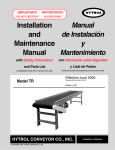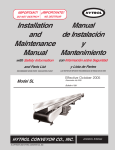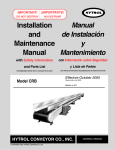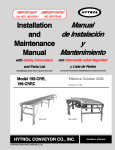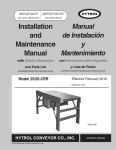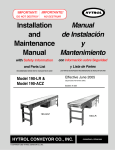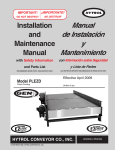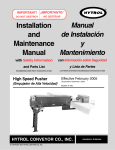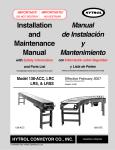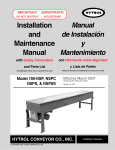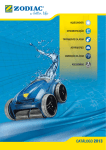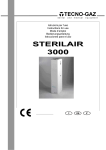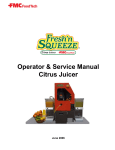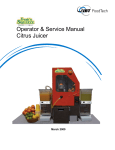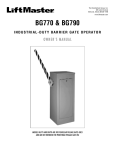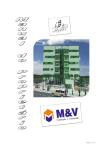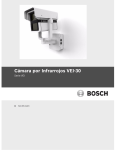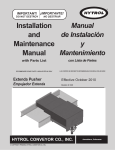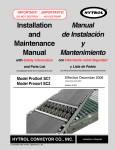Download Instalación - Hytrol Conveyor Company, Inc.
Transcript
IMPORTANT! ¡IMPORTANTE! DO NOT DESTROY NO DESTRUIR Manual Installation de Instalación and y Maintenance Mantenimiento Manual with Safety Information con Información sobre Seguridad and Parts List y Lista de Partes RECOMMENDED SPARE PARTS HIGHLIGHTED IN GRAY LAS PARTES DE REPUESTO RECOMENDADAS SE RESALTAN EN GRIS Model TL Effective October 2006 (Supercedes February 2003) Bulletin # 578 HYTROL CONVEYOR CO., INC. © COPYRIGHT 2006–HYTROL CONVEYOR CO., INC. Jonesboro, Arkansas ● Table of Contents 2 ● Indice Warning Signs . . . . . . . . . . . . . . . . . . . . . . . . .3 Señales de Advertencia . . . . . . . . . . . . . . . . . . .3 INTRODUCTION Receiving and Uncrating . . . . . . . . . . . . . . . . .4 INTRODUCCION Recepción y Desembalaje . . . . . . . . . . . . . . . . .4 INSTALLATION Installation Safety Precautions . . . . . . . . . . . .5 Support Installation . . . . . . . . . . . . . . . . . . . .6 Ceiling Hanger Installation . . . . . . . . . . . . . . .7 Conveyor Set-Up . . . . . . . . . . . . . . . . . . . . . .8 Belt Installation . . . . . . . . . . . . . . . . . . . . . . .10 Electrical Equipment . . . . . . . . . . . . . . . . . . .12 INSTALACION Medidas de Seguridad al Instalar . . . . . . . . . . .5 Instalación de los Soportes . . . . . . . . . . . . . . . .6 Instalación de los Soportes de Techo . . . . . . . . .7 Montaje . . . . . . . . . . . . . . . . . . . . . . . . . . . . . .8 Instalación de la Banda . . . . . . . . . . . . . . . . . .10 Equipo Eléctrico . . . . . . . . . . . . . . . . . . . . . . .12 OPERATION Operation Safety Precautions . . . . . . . . . . .14 Conveyor Start-Up . . . . . . . . . . . . . . . . . . . .15 OPERACION Medidas de Seguridad . . . . . . . . . . . . . . . . . .14 Arranque del Transportador . . . . . . . . . . . . . . .15 MAINTENANCE Maintenance Safety Precautions . . . . . . . . . .16 Lubrication . . . . . . . . . . . . . . . . . . . . . . . . . .17 Belt Tracking . . . . . . . . . . . . . . . . . . . . . . . . .18 Drive Chain Alignment and Tension . . . . . . .21 Trouble Shooting . . . . . . . . . . . . . . . . . . . . .22 Maintenance Checklist . . . . . . . . . . . . . . . . .24 How To Order Replacement Parts . . . . . . .24 MANTENIMIENTO Medidas de Seguridad . . . . . . . . . . . . . . . . . .16 Lubricación . . . . . . . . . . . . . . . . . . . . . . . . . . .17 Alineación de la Banda . . . . . . . . . . . . . . . . . .18 Alineación y Tensión de la Cadena . . . . . . . . . .21 Resolviendo Problemas . . . . . . . . . . . . . . . . . .23 Plan de Mantenimiento . . . . . . . . . . . . . . . . . .25 Como Ordenar Refacciones . . . . . . . . . . . . . . .25 REPLACEMENT PARTS Model TL Parts Drawing & List 8” End Drive . . . . . . . . . . . . . . . . . . . . . . . . .26 8” Center Drive . . . . . . . . . . . . . . . . . . . . . .28 8” Center Drive Assembly . . . . . . . . . . . . . .30 Underside Take-Up . . . . . . . . . . . . . . . . . . . .31 Standard End Power Feeder . . . . . . . . . . . .32 System End Power Feeder . . . . . . . . . . . . . .34 PARTES DE REPUESTO Dibujo y Lista de Partes del Modelo TL 8” Motor de Extremo . . . . . . . . . . . . . . . . . . .26 8” Motor Central . . . . . . . . . . . . . . . . . . . . . .28 Ensamble de la Unidad Central de 8” . . . . . . .30 Ensamble del Tensor Inferior . . . . . . . . . . . . . .31 Alimentador Motriz Estándar . . . . . . . . . . . . .32 Alimentador Motriz de Sistema . . . . . . . . . . . .34 ● Warning Signs ● Señales de Advertencia In an effort to reduce the possibility of injury to personnel working around HYTROL conveying equipment, warning signs are placed at various points on the equipment to alert them of potential dangers. Please check equipment and note all warning signs. Make certain your personnel are alerted to and obey these warnings. Shown below are typical signs that are attached to this equipment. En un esfuerzo por reducir la posibilidad de accidentes del personal trabajando junto al equipo de transportadores HYTROL, se colocan señales de advertencia en diferentes partes del equipo para alertarlos de riesgos potenciales. Por favor verifique el equipo y asegúrese de ver todas las señales de advertencia. Asegúrese de que su personal esté alerta y obedezca las señales. Abajo se muestran las señales que se encuentran en este equipo. PLACED ON ALL POWERED CONVEYORS NEAR DRIVE AND/OR CONTROLS. COLOCADA EN TODOS LOS TRANSPORTADORES MOTORIZADOS CERCA AL MOTOR Y/O LOS CONTROLES PLACED ON ALL CHAIN GUARDS. COLOCADA EN TODAS LAS GUARDA CADENAS. PLACED NEXT TO DRIVE, BOTH SIDES. COLOCADA JUNTO A LA UNIDAD MOTRIZ, EN AMBOS LADOS. PLACED ON 20 FT. INTERVALS,BOTH SIDES. COLOCADA EN INTERVALOS DE 20 PIES, A AMBOS LADOS. PLACED ON TERMINATING ENDS. COLOCADA EN LOS EXTREMOS. PLACED AT DRIVE OF ALL POWERED CONVEYORS. COLOCADA EN LA UNIDAD MOTRIZ DE TODOS LOS TRANSPORTADORES MOTORIZADOS. NOTE: BILINGUAL (SPANISH) LABELS AVAILABLE UPON REQUEST. NOTA: ETIQUETAS BILINGÜES (ESPAÑOL) SERÁN PROVEÍDAS BAJO PETICIÓN. 3 INTRODUCTION This manual provides guidelines and procedures for installing, operating, and maintaining your conveyor. A complete parts list is provided with recommended spare parts highlighted in gray. Important safety information is also provided throughout the manual. For safety to personnel and for proper operation of your conveyor, it is recommended that you read and follow the instructions provided in this manual. ● Receiving and Uncrating 4 INTRODUCCION Este manual provee las pautas y los procedimientos para instalar, operar, y mantener su transportador. Se proporciona una lista completa de re facciones con las recomendadas resaltadas en gris. Se proporciona también información importante para prevención de accidentes en cada una de las partes de este manual. Para seguridad del personal y para un funcionamiento apropiado del transportador, se recomienda que se lean y se sigan cada una de las instrucciones. ● Recepción y Desembalaje 1. . . Check the number of items received against the bill of lading. 2. . . Examine condition of equipment to determine if any damage occurred during shipment. 3. . . Move all crates to area of installation. 4. . . Remove crating and check for optional equipment that may be fastened to the conveyor. Make sure these parts (or any foreign pieces) are removed. 1. . . Compare el número de partes recibidas con las del conocimiento del embarque. 2. . . Examine las condiciones del equipo para determinar si algún daño ha ocurrido durante el transporte. 3. . . Translade el equipo al área de instalación. 4. . . Desempaque y verifique si hay partes opcionales atadas al equipo. Asegúrese de que estas partes (o cualquier otras partes ajenas al equipo) sean removidas. NOTE: If damage has occurred or freight is missing, see the “Important Notice” attached to the crate. NOTA: Si algún daño ha ocurrido o faltan partes, vea las "Notas Importantes" adheridas al embalaje. INSTALLATION ● Installation Safety Precautions for Conveyors and Related Equipment GUARDS AND GUARDING Interfacing of Equipment. When two or more pieces of equipment are interfaced, special attention shall be given to the interfaced area to insure the presence of adequate guarding and safety devices. Guarding Exceptions. Wherever conditions prevail that would require guarding under these standards, but such guarding would render the conveyor unusable, prominent warning means shall be provided in the area or on the equipment in lieu of guarding. Guarded by Location or Position. W h e re necessary for the protection of employees from hazards, all exposed moving machinery parts that present a hazard to employees at their work station shall be mechanically or electrically guarded, or guarded by location or position. When a conveyor passes over a walkway, roadway, or work station, it is considered guarded solely by location or position if all moving parts are at least 8 ft. (2.44 m) above the floor or walking surface or are otherwise located so that the employee cannot inadvertently come in contact with hazardous moving parts. Although overhead conveyors may be guarded by location, spill guard, pan guards, or equivalent shall be provided if the product may fall off the conveyor for any reason and if personnel would be endangered. HEADROOM When conveyors are installed above exit passageways, aisles, or corridors, there shall be provided a minimum clearance of 6 ft. 8 in. (2.032 m) measured vertically from the floor or walking surface to the lowest part of the conveyor or guards. Where system function will be impaired by providing the minimum clearance of 6 ft. 8 in. (2.032 m) through an emergency exit, alternate passageways shall be provided. It is permissible to allow passage under conveyors with less than 6 ft. 8 in. (2.032 m) clearance from the floor for other than emergency exits if a suitable warning indicates low headroom. INSTALACION ● Medidas de Seguridad al Instalar Transportadores y Equipos Relacionados GUARDAS Y PROTECCIONES Ensamble del Equipo. Cuando dos o más piezas del equipo van unidas, debe ponerse especial atención al área de unión para asegurar que las guardas adecuadas y los dispositivos de seguridad, estén presentes. Excepciones de Protección. Dondequiera que las guardas sean necesarias, pero que la colocación de las mismas inhabilite el uso del transportador, se omitirán las guardas y se proporcionarán señales visibles de advertencia ya sea en el área o en el equipo. P rotección dada por Posición o Ubicación. Cuando sea necesaria la protección de los empleados contra posibles riesgos, todas las partes del equipo que estén expuestas y en movimiento, y que puedan presentar peligro, serán protegidas mecánica o eléctricamente, o protegidas por su posición o ubicación. Cuando el transportador está instalado sobre pasillos, corredores o puestos de trabajo, se considera protegido únicamente por localización o posición si todas las partes en movimiento están situadas a mínimo a 8 pies (2.44m) de altura del piso, o si está localizadas de tal manera que el empleado no pueda entrar en contacto inadvertidamente con dichas partes. A pesar de que los transportadores áereos pueden estar protegidos por su localización, guardas laterales e inferiores deben ser proporcionadas para evitar que el producto caiga fuera del transportador y así mantener al personal fuera de peligro. UBICACION SUPERIOR Cuando los transportadores son instalados sobre pasillos o corredores de salida, debe dejarse un espacio libre de mínimo 6 pies 8 pulgadas (2,032m) de altura, midiendo verticalmente desde el piso o área de tránsito hasta la parte más baja del transportador o de las guardas. Si se proporcionan señales de advertencia adequadas indicando baja altura; es posible dejar espacio libre con menos de 6 pies 8 pulgadas (2.032m) de extensión entre el piso y el transportador en los pasillos que no sean salidas de emergencia. 5 ● Support Installation ● Instalación de los Soportes 1. . . Determine primary direction of product flow. Figure 6A indicates the preferred flow as related to the drive. 2. . . R e fer to “Match-Mark” numbers on ends of conveyor sections. (Figure 6A). 3. . . Attach supports to both ends of drive section and to one end of intermediate or tail sections (Figure 6A). Hand tighten bolts only at this time. 4. . . Adjust elevation to required height. 1. . . Determine la dirección primaria del flujo del producto. La figura 6A indica el flujo preferido en relación con la unidad motriz. 2. . . Refiérase a las “Etiquetas de Secuencia de Armado” situadas al final de las secciones del transportador. (Figura 6A). 3. . . Fije los soportes en ambos extremos de la sección motriz y a un extremo de la sección intermedia o final (Figura 6A). Apriete los tornillos manualmente. 4. . . Ajuste la elevación a la altura requerida. FIGURE 6A PRODUCT FLOW ADJUST TO DESIRED ELEVATION FLOW (FLUJO DEL PRODUCTO) (AJUSTE A LA ELEVACION DESEADA) TAIL SECTION INTERMEDIATE OR TAIL SECTION DRIVE SECTION (SECCION DE RETORNO) (SECCION FINAL O INTERMEDIA) (SECCION MOTRIZ) 2” 2” SPLICE PLATE (PLACA DE UNION) NOTE: ALLOW FOR BELT THICKNESS WHEN ADJUSTING SUPPORTS (NOTA :AL AJUSTAR LOS SOPORTES DEJE ESPACIO SEGUN EL ESPESOR DE LA BANDA.) “MATCH-MARK” NUMBERS 4” 6 (ETIQUETAS DE SECUENCIA DE ARMADO) ● Ceiling Hanger Installation ● Instalación de los Soportes a Techo If conveyors are to be used in an overhead application, ceiling hangers may have been supplied in place of floor supports. Figure 7A shows how a ceiling hanger mounts to a conveyor section. Ceiling hangers should be mounted at section joints. For safety information concerning conveyors mounted overhead, refer to “Installation Safety Precautions” on Page 5. NOTE: When installing ceiling hanger rods in an existing building, all methods of attachment must comply with local building codes. Si los transportadores van a ser usados en aplicaciones aéreas o superiores, soportes colgantes del techo pudieron haber sido suministrados en vez de los soportes de piso. La figura 7A muestra como un soporte colgante de techo se instala en un transportador. Los soportes colgantes deben montarse en la unión de las secciones. Para información de seguridad respecto al montaje de transportadores aéreos, refiérase a “Medidas de Seguridad al Instalar” en la página 5. NOTA: Cuando se instalan varillas colgantes al techo en una construcción existente, todos los métodos de unión deben cumplir con los códigos locales de construcción. FIGURE 7A CEILING HANGER ROD (VARILLA COLGANTE AL TECHO) SIDE CHANNEL (CANAL LATERAL) SPACER (ESPACIADOR) JAM NUT (CONTRA TUERCA) SUPPORT PIPE (TUBO DE SOPORTE) PIPE RETAINER (ABRAZADERA) JAM NUT (CONTRA TUERCA) MOUNTING BOLTS (TORNILLO DE MONTAJE) LOCK BOLT (TORNILLO CANDADO) 7 ● Conveyor Set-Up 1. . . Mark a chalk line on floor to locate center of the conveyor (Floor Mounted Conveyors). 2. . . Place the drive section in position. 3. . . Install remaining sections placing end without support on extend support of previous section (Figure 9A). Check “Match Mark” Numbers to see that adjoining sections are in proper sequence 4. . . Fasten sections together with splice plates and pivot plates (Figure 9B). Hand tighten bolts only. 5. . . Check to see that conveyor is level across width and length of unit. Adjust supports as necessary. 6. . . Tighten all splice plates and support mounting bolts and lag conveyor to the floor. 7. . . Install electrical controls and wire motor. See Page 12. 8. . . Install and track belt per instructions on Pages 10 and 18. 8 ● Instalación 1. . . Marque con tiza una línea en el suelo para ubicar el centro del transportador. (Transportadores Montados en el Piso). 2. . . Coloque la sección motriz en posición. 3. . . Instale las secciones restantes, colocando el extremo sin soporte en la placa pivote de la sección anterior (Fig. 9A). Revise las etiquetas de Secuencia de Armado para asegurarse que las secciones unidas estén en el orden correcto. 4. . . Sujete las secciones con placas de unión y placas pivote (Fig. 9B). Apriete los tornillos manualmente. 5. . . Revise si el transportador está nivelado a lo ancho y largo de la unidad. Ajuste los soportes como sea necesario. 6. . . Apriete todas las placas de union y los tornillos de montaje, y ancle el transportador al piso. 7. . . Instale los controles eléctricos y conecte el motor.Vea la Página 12. 8. . . Instale y alinie la banda con las instrucciones de las Páginas 10 y 18. FIGURE 9A DRIVE SECTION (SECCION DE LA UNIDAD MOTRIZ) INTERMEDIATE SECTION (SECCION INTERMEDIA) “MATCH-MARK” NUMBERS (ETIQUETAS DE ARMADO) FIGURE 9B BED SECTION (CAMA) SPLICE PLATE (PLACA DE UNION) BED SECTION MOUNTING BOLT (CAMA) (TORNILLO DE MONTAJE) PIVOT PLATE (PLACA PIVOTE) STATIONARY SUPPORT (SOPORTE ESTACIONARIO) 9 ● Belt Installation The conveyor belt has been pre-cut to the proper length, and lacing installed at the factory.To install follow these steps: 1. . . Thread belt through conveyor as shown in Figure 11B. 2. . . Pull ends together and insert lacing pin (Figure 11A). 3. . . Adjust belt tension with take-up pulley. Keep pulley square by moving both take-up bolts an equal amount. Maintain enough tension so drive pulley will not slip when carrying the rated load. 4. . . Track belt per instructions on Page18. 10 ● Instalación de la Banda La banda del transportador ha sido previamente cortada y enlazada en la fábrica. Para instalarla siga los siguientes pasos: 1. . . Coloque la banda a través del transportador (Figura 11B). 2. . . Junte los extremos e incerte el pasador de enlace (Figura 11A). 3. . . Ajuste la tensión de la banda con las poleas tensoras. Mantenga la polea encuadrada moviendo los tornillos tensores a la misma distancia. Mantenga suficiente tension para que la polea motriz no se resvale cuando transporte la carga estimada. 4. . . Alinie la banda de acuerdo a las instrucciones de la página 18. NOTE: If belt ends cannot be pulled together by hand, it may be necessary to loosen take-ups (at tail pulley, etc.), minimum position or use a belt puller so lacing pin can be easily inserted. NOTA: Si los extremos de la banda no pueden ser unidos manualmente, afloje los tornillos tensores (en la polea de retorno, etc.) ó puede usar un jalador de banda hasta que el pasador pueda ser facilmente insertado.XXXX CAUTION! Excessive slippage will reduce belt life and damage drive pulley lagging. Never apply more tension than is needed. Over-tension will cause extra wear to belt and bearings and will require extra power from drive. ¡PRECAUCION! El patinaje excesivo reducirá la vida de la banda y dañará el revestimiento de la polea motriz. Nunca aplique mas tensión de la necesaria. Una sobre-tensión causará un desgaste extra de la banda y los rodamientos, y requerirá una mayor potencia de la unidad motriz. FIGURE 11A BELT LACING (ENLACE DE BANDA) LACING PIN (PASADOR DE ENLACE) BELT (BANDA) FIGURE 11A BELT INSTALLATION—END DRIVE (INSTALACION DE LA BANDA—UNIDAD MOTRIZ DE EXTREMO) DRIVE PULLEY BELT (BOTTOM SIDE) (POLEA MOTRIZ) (BANDA [LADO INFERIOR]) BELT FLOW BELT (TOP SIDE) TAIL PULLEY (BANDA [LADO SUPERIOR]) (POLEA DE RETORNO) (FLUJO DE BANDA) SNUB IDLER (RODILLO DE ALINEACION) DRIVE RETURN IDLER TAKE-UP BOLT (UNIDAD MOTRIZ) (RODILLO DE RETORNO) (TORNILLO TENSOR) BELT INSTALLATION—CENTER DRIVE OR UNDERSIDE TAKE UP (INSTALACION DE LA BANDA—UNIDAD MOTRIZ CENTRAL O TENSORES MENORES) TAKE-UP SCREW TAKE-UP PULLEY (TORNILLO TENSOR) (POLEA TENSORA) PREFERRED BELT FLOW BELT RETURN IDLER (BANDA) (RODILLO DE RETORNO) (FLUJO PREFERIDO) TAIL PULLEY (POLEA DE RETORNO) TAIL PULLEY (POLEA DE RETORNO) SNUB IDLER SNUB IDLER (RODILLO DE ALINEACION) (RODILLO DE ALINEACION) DRIVE PULLEY CENTER DRIVE (POLEA MOTRIZ) (UNIDAD MOTRIZ CENTRAL) 11 ● Electrical Equipment ● Equipo Eléctrico WARNING! Electrical controls shall be installed and wired by a qualified electrician. Wiring information for the motor and controls are furnished by the equipment manufacturer. ¡ADVERTENCIA! Los controles eléctricos deben ser conectados e instalados por un electricista calificado. La información sobre las conexiones del motor y los controles será proporcionada por el fabricante del equipo. CONTROLS CONTROLES Electrical Code: All motor controls and wiring shall conform to the National Electrical Code (Article 670 or other applicable articles) as published by the National Fire Protection Association and as approved by the American Standards Institute, Inc. Código Eléctrico: Todos los controles del motor y las conexiones deben ajustarse al "National Electrical Code" (Artículo 670 u otros artículos aplicables) como fue publicado por la "National Fire Protection Association" y aprobado por el "American Standards Institute, Inc." CONTROL STATIONS ESTACIONES DE CONTROL A) Control stations should be so arranged and located that the operation of the equipment is visible from them, and shall be clearly marked or labeled to indicate the function controlled. 12 A) Las estaciones de control deberán estar arregladas y ubicadas en lugares donde el funcionamiento del equipo sea visible y deberán estar claramente marcadas o señaladas para indicar la función controlada. B) A conveyor which would cause injury when started shall not be started until employees in the area are alerted by a signal or by a designated person that the conveyor is about to start. When a conveyor would cause injury when started and is automatically controlled or must be controlled from a remote location, an audible device shall be provided which can be clearly heard at all points along the conveyor where personnel may be present. The warning device shall be actuated by the controller device starting the conveyor and shall continue for a required period of time before the conveyor starts. A flashing light or similar visual warning may be used in conjunction with or in place of the audible device if more effective in particular circumstances. Where system function would be seriously hindered or adversely affected by the required time delay or where the intent of the warning may be misinterpreted (i.e., a work area with many different conveyors and allied devices), clear, concise, and legible warning shall be provided. The warning shall indicate that conveyors and allied equipment may be started at any time, that danger exists, and that personnel must keep clear. The warnings shall be provided along the conveyor at areas not guarded by position or location. B) Un transportador que pueda causar lesiones cuando es puesto en marcha, no deberá ponerse en funcionamiento hasta que los trabajadores en el área sean alertados por una señal o por una persona designada. Cuando un transportador pueda causar lesiones al arrancar y es automáticamente controlado, o tiene que ser controlado desde una ubicación lejana, se deberá proporcionar un dispositivo sonoro el cual pueda ser escuchado claramente en todos los puntos a lo largo del transportador donde el personal pueda estar presente. El dispositivo de advertencia deberá ser activado por el dispositivo de arranque del transportador y deberá continuar sonando por un determinado periodo de tiempo antes de que el transportador empiece a funcionar. Una luz intermitente o una advertencia visual similar puede ser utilizada con o en lugar del dispositivo sonoro si es más efectivo de acuerdo a las circunstancias. Cuando el funcionamiento del sistema pueda ser seriamente obstruido o adversamente afectado por el tiempo de retardo requerido, o cuando el intento de advertencia pueda ser mal interpretado (ej., un área de trabajo con diversas líneas de transportadores y los dispositivos de advertencia relacionados), advertencias claras, concisas y legibles deben ser proporcionadas. Las advertencias deben indicar que los transportadores y los equipos relacionados pueden ser puestos en marcha en cualquier momento, que existe un peligro y que el personal debe mantenerse alejado. Estas advertencias deben ser proporcionadas a lo largo del transportador en áreas que no sean protegidas por la posición o la ubicación. C) Remotely and automatically controlled conveyors, and conveyors where operator stations are not manned or are beyond voice and visual contact from drive areas, loading areas, transfer points, and other potentially hazardous C) Los transportadores controlados automáticamente y desde estaciones lejanas, y los transportadores donde las estaciones de funcionamiento no estén controladas por una persona o estén más locations on the conveyor path not guarded by location, position, or guards, shall be furnished with emergency stop buttons, pull cords, limit switches, or similar emergency stop devices. All such emergency stop devices shall be easily identifiable in the immediate vicinity of such locations unless guarded by location, position, or guards. Where the design, function, and operation of such conveyor clearly is not hazardous to personnel, an emergency stop device is not required. The emergency stop device shall act directly on the control of the conveyor concerned and shall not depend on the stopping of any other equipment. The emergency stop devices shall be installed so that they cannot be overridden from other locations. D) Inactive and unused actuators, controllers, and wiring should be removed from control stations and panel boards, together with obsolete diagrams, indicators, control labels, and other material which serve to confuse the operator. SAFETY DEVICES A) All safety devices, including wiring of electrical safety devices, shall be arranged to operate in a “Fail-Safe” manner, that is, if power failure or failure of the device itself would occur, a hazardous condition must not result. B) Emergency Stops and Restarts. Conveyor controls shall be so arranged that, in case of emergency stop, manual reset or start at the location where the emergency stop was initiated, shall be required of the conveyor(s) and associated equipment to resume operation. C) Before restarting a conveyor which has been stopped because of an emergency, an inspection of the conveyor shall be made and the cause of the stoppage determined. The starting device shall be locked out before any attempt is made to remove the cause of stoppage, unless operation is necessary to determine the cause or to safely remove the stoppage. Refer to ANSI Z244.1-1982, American National Standard for Personnel Protection – Lockout/Tagout of Energy Sources – Minimum Safety Requirements and OSHA Standard Number 29 CFR 1910.147 “The Control of Hazardous Energy (Lockout/Tagout).” allá del alcance de la voz y del contacto visual de las áreas de conducción, áreas de carga, puntos de transferencia y otros sitios potencialmente peligrosos localizados en la tra yectoria del transportador que no tenga protección por posición, ubicación, o guardas, deberán ser equipados con interruptores de parada de emergencia, cordones de parada de emergencia, interruptores de límite o dispositivos similares para paradas de emergencia. Todos estos dispositivos de parada de emergencia deberán ser fácilmente identificables en las cercanías inmediatas a estos puntos potencialmente peligrosos, a no ser que estén protegidos dada su ubicación, posición o protegidos con guardas. Donde el diseño, el funcionamiento, y la operación de tales transport a d o res no represente un claro peligro para el personal, no se requieren los dispositivos de parada de emergencia. El dispositivo de parada de emergencia debe actuar directamente en el control del transportador concerniente y no debe depender de la parada de cualquier otro equipo. Los dispositivos de parada de emergencia deben ser instalados de tal forma que no puedan ser anulados desde otras localidades. D) Los controles, los actuadores inactivos o no usados y los cables, deberán ser removidos de las estaciones de control y de los tableros de mando, junto con los diagramas, indicadores, etiquetas de control y otros materiales obsoletos, los cuales pueden confundir al operador. DISPOSITIVOS DE SEGURIDAD A) Todos los dispositivos de seguridad, incluyendo la conexión de dispositivos eléctricos, deben estar dispuestos para operar en una manera de "autoprotección"; es decir, si se presenta una pérdida de corriente o un fallo en el mismo dispositivo, esto no debe representar peligro. B) Paradas de Emergencia y Reactivadores. Los controles del transportador deberán estar dispuestos de tal manera que en caso de una parada de emergencia, se requiera un activador o arrancador manual en la ubicación donde la parada de emergencia se presenta para poder reanudar la operación del transportador o transportadores y equipo asociado. C) Antes de volver a poner en marcha un transportador que haya sido detenido por una emergencia, debe revisarse y determinar la causa de la parada. El dispositivo de arranque deberá ser bloqueado antes de intentar corregir o remover la causa que originó la parada, a no ser que la operación del transportador sea necesaria para determinar la causa o para solucionar el problema. Refiérase a ANSI Z244.1-1982, "American National Standard for Personnel Protection" - Lockout/Ta gout of Energy Sources Minimum Safety Requirements and OSHA Standard Number 29 CFR 1910.147 "The Control of Hazardous Energy (Lockout/Tagout)." 13 OPERATION ● Operation Safety Precautions ● Medidas de Seguridad en la Operación A) Only trained employees shall be permitted to operate conveyors. Training shall include instruction in operation under normal conditions and emergency situations. A) Solo se debe permitir operar los transportadores a empleados entrenados. El entrenamiento debe incluir instrucciones de operación bajo condiciones normales y en situaciones de emergencia. B) Where employee safety is dependent upon stopping and/or starting devices, they shall be kept free of obstructions to permit ready access. B) Cuando la seguridad de los trabajadores dependa de dispositivos de parada y/o arranque, tales dispositivos deben mantenerse libres de obstrucciones para permitir un acceso rápido. C) The area around loading and unloading points shall be kept clear of obstructions which could endanger personnel. D) No person shall ride the load-carrying element of a conveyor under any circumstances unless that person is specifically authorized by the owner or employer to do so. Under those circumstances, such employee shall only ride a conveyor which incorporates within its supporting s t r u c t u re, platforms or control stations specifically designed for carrying personnel. Under no circumstances shall any person ride on any element of a vertical conveyor. Owners of conveyors should affix warning devices to the conveyor reading Do Not Ride Conveyor. E) Personnel working on or near a conveyor shall be instructed as to the location and operation of pertinent stopping devices. F) A conveyor shall be used to transport only material it is capable of handling safely. G) Under no circumstances shall the safety characteristics of the conveyor be altered if such alterations would endanger personnel. 14 OPERACION C) El área alrededor de los puntos de carga y descarga debe mantenerse libre de obstrucciones, las cuales podrían poner en peligro al personal. D) Ninguna persona debe subirse en la parte de conducción de carga de un transportador bajo ninguna circunstancia al menos que esta persona sea autorizada por el dueño o por el supervisor. Bajo estas circunstancias, el empleado debe subirse solamente en un tra n s p o rtador que tenga i n c o r p o radas dentro de su estructura, p l a t a formas o estaciones de control especialmente diseñadas para el traslado de personal. Bajo ninguna circunstancia, persona alguna debe subirse en cualquier parte de un transportador vertical. Los dueños de los transportadores deben añadir señales de advertencia al transportador con el texto: "No subirse en el Transportador". E) El personal que esté trabajando en o cerca al transportador, debe ser instruído en cuanto a la ubicación y operación de los dispositivos de parada. F) Un transportador debe ser utilizado para transportar solo los productos que sea capaz de manejar con seguridad. G) Bajo ninguna circunstancia las características de seguridad de un transportador deben ser alteradas si tales alteraciones puden poner en peligro al personal. H) Routine inspections and preventive and corrective maintenance programs shall be conducted to insure that all safety features and devices are retained and function properly. I) Personnel should be alerted to the potential hazard of entanglement in conveyors caused by items such as long hair, loose clothing, and jewelry. J) As a general rule, conveyors should not be cleaned while in operation. Where proper cleaning requires the conveyor to be in motion and a hazard exists, personnel should be made aware of the associated hazard. ● Conveyor Start-Up H) Inspecciones rutinarias deben llevarse a cabo al igual que programas de mantenimiento preventivos y correctivos, con la finalidad de asegurar que todos los dispositivos y medidas de seguridad sean conservados en buen estado y funcionen correctamente. I) El personal debe ser advertido de las posibles causas de peligros potenciales tales como enredos en transportadores por llevar cabello largo, ropa suelta o joyas, etc. J) Como regla general, los transportadores no deberán limpiarse mientras estén en funcionamiento. Cuando se requiera limpiar el transportador estando en movimiento y exista posibilidad de peligro, el personal deberá ser advertido de ese posible riesgo. ● Arranque del Transportador Before conveyor is turned on, check for foreign objects that may have been left inside conveyor during installation. These objects could cause serious damage during start-up. After conveyor has been turned on and is operating, check motors, reducers, and moving parts to make sure they are working freely. Antes de poner en marcha el transportador, revise si hay objetos ajenos que puedan haber sido dejados dentro del transportador durante la instalación. Estos objetos pueden causar serios daños durante el arranque. Después de poner en marcha el transportador y que esté operando, revise los motore s, reductores y partes en movimiento para estar seguro de que están trabajando libremente. CAUTION! Because of the many moving parts on the conveyor, all personnel in the area of the conveyor need to be warned that the conveyor is about to be started. ¡PRECAUCION! Debido a la cantidad de partes en movimiento del transportador, todo el personal en el área del transportador necesita ser advertido de que este está a punto de ponerse en marcha. 15 MAINTENANCE ● Maintenance Safety Precautions ● Medidas de Seguridad en el Mantenimiento A) Maintenance, such as lubrication and adjustments, shall be performed only by qualified and trained personnel. A) El mantenimiento, tal como lubricación y ajustes, debe ser realizado solamente por personal calificado y entrenado. B) It is Important that a maintenance program be established to insure that all conveyor components are maintained in a condition which does not constitute a hazard to personnel. B) Es importante que se establezca un programa de mantenimiento, para asegurar que todos los componentes del transportador sean mantenidos en condiciones que no constituyan un peligro para el personal. C) When a conveyor is stopped for maintenance purposes, s t a rting devices or powered accessories shall be locked or tagged out in accordance with a formalized procedure designed to protect all person or groups involved with the conveyor against an unexpected start. C) Cuando un transportador esté parado por razones de mantenimiento, los dispositivos de arranque o accesorios motorizados deben ser asegurados o desconectados siguiendo un procedimiento diseñado para evitar cualquier arranque inesperado que pueda causar heridas a la persona o grupos de p e rsonas involucrados con el transportador. D) Replace all safety devices and guards before starting equipment for normal operation. E) Whenever practical, DO NOT lubricate conveyors while they are in motion. Only trained personnel who are aware of the hazard of the conveyor in motion shall be allowed to lubricate. 16 MANTENIMIENTO D) Antes de poner en marcha el equipo, vuelva a colocar todas las guardas y dispositivos de seguridad en su lugar. E) Siempre que sea práctico, NO l u b rique los transportadores mientras se encuentren en movimiento. Solo el pers o n a l entrenado, que tenga conocimiento de los peligros del transportador en movimiento, se le permitirá lubricarlos de esta manera. SAFETY GUARDS Maintain all guards and safety devices IN POSITION and IN SAFE REPAIR. PROT E CCIONES DE SEGURIDAD Mantenga todas las guardas y dispositivos de seguridad EN SU POSICION y EN BUENAS CONDICIONES. WARNING SIGNS Maintain all warning signs in a legible condition and obey all warnings. See Page 3 of this manual for examples of warning signs. SEÑALES DE ADVERTENCIA Mantenga todas las señales de advertencia en condiciones legibles y obedézcalas. Remítase a la página 3 de este manual para ver ejemplos de señales de advertencia. ● Lubrication ● Lubricación The drive chain is pre-lubricated from the manufacturer by a hot dipping process that ensures total lubrication of all components. However, continued proper lubrication will greatly extend the useful life of every drive chain. D r i ve Chain lubrication serves several purposes including: • Protecting against wear of the pin-bushing joint • Lubricating chain-sprocket contact surfaces • Preventing rust or corrosion For normal operating environments, lubricate every 2080 hours of operation or every 6 months, whichever comes first. Lubricate with a good grade of nondetergent petroleum or synthetic lubricant (i.e., Mobile 1 Synthetic). For best results, always use a brush to generously lubricate the chain. The proper viscosity of lubricant greatly affects its ability to flow into the internal areas of the chain. Refer to the table below for the proper viscosity of lubricant for your application. Ambient Temperature Degrees F 20-40 40-100 100-120 SAE ISO 20 30 40 46 or 68 100 150 The drive chain’s lubrication requirement is greatly a f fected by the operating conditions. For harsh conditions such as damp env i ro n m e n t s , dusty e nv i ro n m e n t s , e x c e s s i ve speeds, or elev a t e d temperatures, it is best to lubricate more frequently. It may be best, under these conditions, to develop a custom lubrication schedule for your specific application. A custom lubrication schedule may be developed by inspecting the drive chain on regular time intervals for sufficient lubrication. Once the time interval is determined at which the chain is not sufficiently lubricated, lubricate it and schedule the future lubrication intervals accordingly. La cadena motriz ha sido pre-lubricada por el fabricante mediante un proceso de sumersión caliente que asegura una lubricación total de todos sus componentes. Sin embargo, una lubricación apropiada y continua extenderá su vida útil enormemente. La lubricación de la cadena motriz cumple varios propósitos: • Proteger contra el desgaste de la unión de pines de la cadena • Lubricar las superficies de contacto entre la cadena y el sprocket • Prevenir la oxidación o corrosión. En operaciones bajo condiciones ambientales normales, lubrique cada 2080 horas de operación o cada 6 meses, lo que ocurra primero. Lubrique con un lubricante sintético (ej. Mobile 1 sintético) o basado en petroleo no-detergente de buen grado. Para mejores resultados, siempre utilice una brocha para lubricar la cadena generosamente. La viscosidad apropiada del lubricante afecta enormente el fluido del mismo hacia las áreas internas de la cadena. Refiérase a la siguiente tabla para consultar la viscosidad de lubricante adecuada para su aplicación. Temperatura Ambiente (Grados Fº) (Grados Cº) 20-40 -07 – 04 40-100 04 – 38 100-120 38 – 49 SAE ISO 20 30 40 46 o 68 100 150 El requerimiento de lubricación de la cadena motriz se vé afectado por las condiciones de operación. En condiciones difíciles tales como: ambientes humedos, ambientes con polvo, velocidades excesivas, o temperaturas elevadas, se recomienda lubricar la cadena con más frecuencia. Lo apropiado sería que bajo estas condiciones se establezca un programa de lubricación específico para su aplicación. Este p rog rama podrá llev a rse a cabo inspeccionando la lubricacion suficiente de la cadena motriz en intervalos regulares de tiempo. Una vez se ha determinado el intervalo en el cual la cadena no se encuentra suficientemente lubricada, lubríquela y programe los siguientes intervalos de acuerdo al intervalo anterior. 17 ● Belt Tracking ● Alineación de la Banda HOW IS THE CONVEYOR BELT TRACKED The belt is tracking by adjusting: Drive Pulley,Tail Pulley, Return Idlers, and Snub Idlers. The same tracking principles apply to conveyors supplied with end drives, center drives, or underside take-ups. PRE-TRACKING INSPECTION Before attempting to physically track the belt: 1. . . Make sure conveyor is level across the width and length of unit. Adjust supports as necessary. 2. . . Check to make sure: Drive Pulley, Tail Pulley, Snub Idlers, and all Return Idlers are square with conveyor bed. See illustrations 18A, 19A, 19B and 19C. Dimension “A” should be equal on both sides of unit. 3. . . M a ke sure belt has been pro p e r ly threaded through conveyor. See “Belt Installation”, Page 10. 4. . . Check for improper loading. Feed should be in direction of belt travel, centered on belt. 5. . . Make sure belt lacing has been installed correctly and is square with the belt. COMO ES LA BANDA ALINEADA La banda se alinea al ajustar: La Polea Motriz, Polea de Retorno, Rodillos de Retorno, y Rodillos de Ajuste. Los mismos pricipios de ajuste se aplican a los transportadores de unidad motriz en el extremo, unidad central motriz o tensores inferiores. INSPECCION PRE-ALINEACION Antes de intentar alinear la banda: 1. . . Asegúrese de que el transportador está nivelado a lo ancho y largo de la unidad. Ajuste los soportes como sea necesario. 2. . . Asegúrese de que la Polea Motriz, la Polea de Retorno, y los Rodillos de Alineación están encuadrados con la cama del transportador.Vea las figuras 18A, a la 19C. La Dimensión “A” debe ser igual en ambos lados de la unidad. 3. . . Aseguresé de que la banda haya sido propiamente colocada en el transportador. Vea “Instalación de la Banda”, Pág. 10. 4. . . Revise si es cargado impropiamente. El alimentador debe estar en dirección hacia donde la banda viaja, centrado en la banda. 5. . . Asegúrese de que el enlace está correctamente instalado y encuadrado con la banda. FIGURE 18A ADJUSTABLE IDLER BRACKET (SOPORTE AJUSTABLE DEL RODILLO) “A” ADJUSTMENT BOLTS DRIVE PULLEY BEARING (TORNILLOS DE AJUSTE) (RODAMIENTOS DE LA POLEA MOTRIZ) DRIVE PULLEY (POLEA MOTRIZ) CHAIN GUARD (GUARDA CADENA) ADJUSTMENT BOLTS SNUB IDLER (TORNILLOS DE AJUSTE) (RODILLO DE ALINEACION) SQUARING 8” END DRIVE 18 FIGURE 19A FIGURE 19B ADJUSTMENT BOLTS ADJUSTMENT BOLTS RETURN BELT (TORNILLO DE AJUSTE) (TORNILLO DE AJUSTE) (BANDA DE RETORNO) SNUB IDLER (RODILLO DE ALINEACION) RETURN IDLER ADJUSTABLE IDLER BRACKET ADJUSTABLE IDLER BRACKET (RODILLO DE RETORNO) (PLACA DE AJUSTE) (SOPORTE AJUSTABLE DEL RODILLO) SQUARING RETURN PULLEY TAIL PULLEY (POLEA DE RETORNO) “A” TAKE-UP BOLT (TORNILLOS TENSORES) SQUARING TAIL PULLEY FIGURE 19C ADJUSTABLE IDLER BRACKET (SOPORTE AJUSTABLE DEL RODILLO) “A” TAKE-UP PULLEY PULLEY BEARING (POLEA TENSORA) (RODAMIENTO DE POLEA) ADJUSTMENT BOLTS (TORNILLO DE AJUSTE) TAKE-UP SCREW (TORNILLO TENSOR) PULLEY (POLEA) SNUB IDLER (RODILLO DE ALINEACION) ADJUSTMENT BOLTS (TORNILLOS DE AJUSTE) SQUARING PULLEYS IN CENTER DRIVE OR UNDERSIDE TAKE-UP CAUTION! Only trained personnel should track conveyor belt which must be done while conveyor is in operation. ¡PRECAUCION! Solo el personal entrenado deberá ajustar la banda del transportador ya que se debe hacer cuando el transportador está operando. 19 IMPORTANT: When belt tracking adjustments are made, they should be minor (1/16 in. at a time on idlers, etc., should be sufficient.). Give the belt adequate time to react to the adjustments. It may take several complete revolutions around the conveyor for the belt to begin tracking properly on long, slow conveyor lines. A) Stand at tail pulley looking toward drive and note what direction belt is traveling. B) Having observed belt and determined tracking problem, follow procedures in “How to Steer The Belt”, See Figure 20A. HOW TO STEER THE BELT Condition 1. . .When the belt is running in the direction (FLOW) with the arrow, but tracking (drifting) towards Side “X”, move the Snub Idler nearest the INFEED end of Side “Y” towards the DISCHARGE end of the conveyor. Condition 2. . . When the belt is running in the direction (FLOW) with the arrow, but tracking (drifting) towards Side “Y”, move the Snub Idler nearest the INFEED end of Side “X” towards the DISCHARGE end of the conveyor. If Belt Direction (FLOW) is reversed, all the above conditions will remain the same as in Figure 20A, except you are now viewing the conveyor from the opposite end. If belt continues to track improperly, re-check all items cove red in “ P re - Tracking Inspection” and make corrections as necessary. IMPORTANTE: Cuando se hagan ajustes a la banda deberán hacerse lo menor posible (1/16” a la vez en los rodillos de retorno, etc., será suficiente). Dele a la banda el tiempo adecuado para que se ajuste. En transportadores largos y lentos, tal vez tomará varias vueltas antes de que quede ajustado. A) Párese en la polea de retorno y observe hacia que dirección la banda corre. B) Despues de haber observado la banda y determinado el ajuste, siga los procedimientos en “Como Dirigir la Banda”, Vea la figura 20A. COMO DIRIGIR LA BANDA Condición 1. . .Cuando la banda está corriendo en dirección de la flecha (FLUJO), pero se desvia hacia el LADO “X”, mueva el Rodillo de Alineación más cercano del extremo de CARGA del LADO “Y” hacia el extremo de DESCARGA del transportador. Condición 2. . . Cuando la banda está corriendo en dirección de la flecha (FLUJO) pero se desvia hacia el LADO “Y”, mueva el Rodillo de Alineación mas cercano al extremo de CARGA del LADO “X” hacia el extremo de DESCARGA del transportador. Sí la banda corre en reversa del FLUJO, todas las condiciones serán las mismas (Figura 20A), exceptuando que ahora usted está viendo el transportador por el lado opuesto. Sí la banda continua estando mal alineada entonces revise todos los objetivos de la sección “Inspección Pre-Alineación” y haga las correcciones necesarias. FIGURE 20A NOTE: In all conditions, you are viewing the Conveyor Belt from the INFEED end. All corrections will be made from the INFEED end of conveyor. 20 NOTA: En todas las condiciones, el transportador se observará desde el punto de CARGA. Todas las correciones serán hechas desde este mismo punto. ● Drive Chain Alignment ● Alineación y Tensión and Tension de la Cadena Motriz The drive chain and sprockets should be checked periodically for proper tension and alignment. Improper adjustment will cause extensive wear to the drive components. La cadena motriz y las catarinas deben ser revisadas periódicamente para que estén correctamente tensas y alineadas. Ajustes impropios causarán un desgaste excesivo. TO MAKE ADJUSTMENTS 1. . . Remove chain guard. 2. . . Check sprocket alignment by placing a straightedge across the face of both sprockets (Figure 21A). Loosen set screws and adjust as needed. Re-tighten set screws. 3. . . To adjust chain tension, loosen bolts that fasten motor base to mounting angles, both sides of the conveyor. 4. . . Tighten take-up bolts until desired chain tension is reached. (Figures 21B & 21C). Re-tighten mounting bolts. 5. . . Lubricate chain per lubrication instructions. 6. . . Replace chain guard so that it does not interfere with drive. PARA AJUSTAR 1. . . Remueva la guarda de cadena. 2. . . Revise la alineación de las catarinas colocando un nivelador sobre sus caras (Fig. 21A). Suelte los tornillos y ajuste las catarinas a la medida necesaria. Apriete los tornillos. 3. . . Para ajustar la tensión de la cadena, suelte los tornillos que unen la base del motor a los ángulos de montura en ambos lados del transportador. Apriete los tornillos tensores hasta que consiga la tensión de la cadena deseada. (Fig. 21B & 21C). Atornille nuevamente. 4. . . Verifique que ambos lados esten ajustados al mismo nivel para evitar que las catarinas queden desalineadas. Apriete los tornillos de montura. 5. . . Lubrique la cadena siguiendo las instruciones. 6. . . Coloque la guarda de cadena de manera que no interfiera con la unidad motriz. FIGURE 21A STRAIGHT EDGE CAUTION! Never remove chain guards while the conveyor is running. Always replace guards after adjustments are made. ¡PRECAUCION! Nunca remueva la guarda de cadena cuando el transportador esté en funcionamiento. Siempre coloque las guardas después de que los ajustes sean hechos. (NIVEL) DRIVE SHAFT SPROCKET (EJE DE TRANSMISION) SET SCREWS REDUCER SPROCKET (TORNILLOS CANDADOS) (CATARINA DEL REDUCTOR) GEAR REDUCER (REDUCTOR) FIGURE 21C FIGURE 21B MOTOR BASE PLATE MOUNTING BOLTS (PLACA DEL MOTOR BASE) (TORNILLOS DE MONTAJE) CHAIN TOO TIGHT (REQUIRES EXTRA POWER) TAKE-UP BOLTS (POLEA MOTRIZ) (CATARINA DE LA POLEA MOTRIZ) (CADENA DEMASIADO FLOJA) (CADENA DEMASIADO TENSA [REQUIERE MAS POTENCIA]) DRIVE PULLEY DRIVE PULLEY SPROCKET CHAIN TOO LOOSE SPROCKET CENTERS (CENTROS DE CATARINAS) (TORNILLOS TENSORES) MOTOR/REDUC ER DRIVE REDUCER SPROCKET (MOTOR/REDUCTOR MOTRIZ) (CATARINA DEL REDUCTOR) CORRECT SLACK (TENSION CORRECTA) APPROX. 1/4” OR 2% OF SPROCKET CENTERS (1/4” O 2% DE CENTROS DE CATARINAS APROX.) 21 ● Trouble Shooting The following charts list possible problems that may occur in the operation of the conveyor. TROUBLE SHOOTING DRIVES TROUBLE Conveyor will not start or motor quits frequently. Drive chain and sprockets wear excessively. Loud popping or grinding noise. CAUSE 1) Motor is overloaded. 2) Motor is drawing too much current. 1) Check for overloading of conveyor. 2) Check heater or circuit breaker and change if necessary. 1) Lack of lubrication on chain causing chain stretch which creates improper chain to sprocket mesh. 2) Sprockets are out of alignment. 3) Loose chain. 1) Replace chain and sprockets. Provide adequate lubrication. NOTE: If problem reoccurs, a chain take-up may be required. 1) Defective bearing. 2) Loose set screws in bearing. 3) Loose drive chain. 1) Replace bearing. 2) Tighten set screw. 3) Tighten chain. 1) Conveyor is overloaded. 1) Check capacity of conveyor and reduce load to recommended level. 2) Have electrician check and correct as necessary. 3) Relubricate per manufacturer’s recommendations. For HYTROL reducer, refer to separate manual. Motor or reducer overheating. 2) Low voltage to motor. 3) Low lubricant level in reducer. Belt does not move, but drive runs. SOLUTION 1) Conveyor is overloaded. 2) Belt is too loose. 3) Lagging on drive pulley is worn. 2) Align sprockets. See “Drive Chain Alignment and Tension”. 3) Tighten chain. 1) Reduce load. 2) Use belt take-up to tighten belt. 3) Replace drive pulley lagging and tighten belt. TROUBLE SHOOTING DRIVE BELT TRACKING TROUBLE CAUSE 1) Entire length of belt creeps off at one spot only. 2) 3) Belt creeps to one side at tail pulley. Entire belt creeps to one side. 22 1) SOLUTION One or more idlers (usually near trouble spot) are out of line. One conveyor section not level or square. Material build-up on pulleys or idlers. 1) Adjust idlers as necessary. See “Tracking the belt” in this manual for details. 2) Make necessary adjustments to supports. 3) Remove residue from pulleys or idlers. install belt, cleaners, or scrappers if possible. Tail pulley, return idler, or snub idler near tail pulley not properly aligned or square with bed. 1) Adjust as necessary. See “Belt Tracking Pre-Tracking Inspection” in this manual for details. 1) Conveyor not straight. 2) Conveyor not level. 3) Material build-up on rollers, pulleys, or idlers. 1) Re-align bed sections as necessary. 2) Correct as necessary. 3) Remove residue and install belt cleaners or scrapers if possible. ● Resolviendo Problemas La siguiente gráfica muestra una lista de posibles problemas que pueden ocurrir durante la operación del transportador RESOLVIENDO PROBLEMAS DE TRANSMISION PROBLEMA CAUSA SOLUCION El transportador no arranca o el motor se detiene frecuentemente. 1) El motor está sobrecargado. 2) El motor pasa demasiada corriente. 1) Revise si hay sobrecarga del transportador. 2) Revise los circuitos e interruptores de protección y sobrecarga, y cámbielos si es necesario. Desgaste excesivo de la cadena motriz y las catarinas. 1) Falta de lubricación en la cadena causando su extensión lo cual crea una cadena inapropiada. 2) Los catarinas están desalineadas. 3) La cadena está floja. 1) Reemplace la cadena y las catarinas. Proporcione una adecuada lubricación. NOTA: Si se presentan problemas, posiblemente se requiere tensionar la cadena. 2) Alinee catarinas. Vea “Alineación y Tensión de Cadena Motriz” . 3) Tensione la cadena. Funcionamiento muy ruidoso. 1) Rodamientos defectuosos. 2) El tornillo candado está flojo en el rodamiento. 3) La cadena está floja. 1) Reemplace los rodamientos. 2) Apriete el tornillo candado. 3) Tensione la cadena. Motor o reductor recalentado. 1) Transportador está sobrecargado. 2) Bajo voltaje al motor. 3) Bajo nivel de lubricante en reductor. 1) Revise la capacidad del transportador y reduzca la carga al nivel recomendado. 2) Haga un chequeo por un electricista y corrija si es necesario. 3) Vuelva a lubricar de acuerdo a las recomendaciones del fabricante. Para el reductor HYTROL, refiérase al manual adjunto. La banda no se mueve, pero el motor corre. 1) El transportador está sobrecargado. 2) La banda está floja. 3) El revestimiento de la polea motriz esta gastada. 1) Reduzca la carga. 2) Use tensores de banda para apretar la banda. 3) Reemplaze el revestimiento de la polea y apriete la banda. RESOLVIENDO PROBLEMAS DE ALINEACION DE LA BANDA MOTRIZ PROBLEMA La banda se desliza en un punto. CAUSA 1) 2) 3) La banda se desliza hacia un lado en la polea de retorno. Toda la banda se desliza hacia un lado. 1) SOLUCION Uno o más rodillos (usualmente cerca del punto del problema) están desalineados. Una o más secciones están desniveladas o desencuadradas. Acumulación de material en rodillos o poleas. 1) Ajuste los rodillos como sea necesario. Use la sección “Alineación de la banda” como referencia. 2) Ajuste los soportes como sea necesario. 3) Remueva el residuo de los rodillos o poleas. Aplique los limpiadores de banda o raspadores si es posible. La polea de retorno, rodillo de retorno o el rodillo de alineación cerca de la polea de retorno no está alineada o encuadrada con la cama. 1) Ajuste como sea necesario.Vea “Inspección Pre-Alineación de la Banda” en este manual. 1) El transportador no está derecho. 2) El transportador no está nivelado. 3) Material acumulado en rodillos o poleas. 1) Realinie las secciones de cama como sea necesario. 2) Conecte como sea necesario. 3) Remueva el residuo y aplique los limpiadores de banda o raspadores si es posible. 23 ● Preventive Maintenance Checklist The following is a general maintenance checklist which covers the major components of your conveyor.This will be helpful in establishing a standard maintenance schedule. COMPONENT MOTOR REDUCER BELT BEARINGS (Pulleys & Rollers) DRIVE CHAIN SPROCKETS V-BELTS STRUCTURAL SUGGESTED ACTION SCHEDULE Weekly Monthly Quarterly Check Noise Check Temperature Check Mounting Bolts Check Noise Check Temperature Check Oil Level Check Tracking Check Tension Check Lacing Check Noise Check Mounting Bolts Check Noise Lubricate Check for Wear Check for Wear Check Set Screws & Keys Check Tension Check for Wear Check for Sheave Alignment General Check:All loose bolts, etc., tightened NOTE: Check Set Screws after the first 24 Hours of operation. ● How to Order Replacement Parts Included in this manual are parts drawings with complete replacement parts lists. Minor fasteners, such as nuts and bolts, are not included. When ordering replacement parts: 1. . . Contact Dealer from whom conveyor was purchased or nearest HYTROL Distributor. 2. . . Give Conveyor Model Number and Serial Number or HYTROL Factory Order Number. 3. . . Give Part Number and complete description from Parts List. 4. . . Give type of drive. Example—8” End Drive, 8” Center Drive, etc. 5. . . If you are in a breakdown situation, tell us. HYTROL Serial Number (Located near Drive on Powered Models). 24 ● Lista de Mantenimiento Preventivo La siguiente es una lista de verificación de mantenimiento preventivo, la cual cubre los principales componentes de su transportador. Esta lista le será útil para establecer un programa estándar de mantenimiento. COMPONENTE REMEDIO HORARIO Semanal Mensual Trimestral Revisar Ruido MOTOR Revisar la Temperatura Revisar los Tornillos de Montaje Revisar Ruido REDUCTOR Revisar la Temperatura Revisar el Nivel del Aceite Revisar la Alineación BANDAS Revisar la Tensión Revisar el Enlace RODAMIENTOS Revisar Ruido Revisar los Tornillos de Montaje Revisar Ruido CADENA MOTRIZ Lubricar Revisar el Desgaste CATARINAS Revisar el Desgaste Revisar los Tornillos y Juegos Revisar la Tensión BANDAS -V Revisar el Desgaste Revisar la Alineación de la Polea ESTRUCTURA Revisión General: Tornillos flojos, etc. NOTA: Revise los tornillos tensores 24 horas despues de la primera operación. ● Como Ordenar Partes de Repuesto Los dibujos de las partes con listas completas de las partes de repuesto están incluidos en este manual. Partes tales como tornillos y tuercas no están incluidas. Para ordenar partes de repuesto: 1. . . Contacte la persona que le vendió el transportador o el distribuidor de Hytrol más cercano. 2. . . Proporcione el Modelo del Transportador y el Número de Serie o Número de la Orden de Fabricación. 3. . . Proporcione el Número de la parte y descripción completa que aparece en la Lista de Partes de Repuesto. 4. . . Proporcione el tipo de motor. Ejemplo—Unidad Motriz de 8" en el Extremo, Unidad Motriz Central 8", etc. 5. . . Si está en una situación crítica, c o mu n í q u e n o s l o inmediatamente. Número de Serie HYTROL (Localizado cerca a la Unidad Motriz en los modelos motorizados). 25 ● Model TL Parts Drawing (8” End Drive) Dibujo de Partes del Modelo TL (8” Motor de Extremo) 4 IN DIA TAIL PULLEY 6 IN DIA TAIL PULLEY SECTION “A-A” 26 ● Model TL Parts List (8” End Drive) Lista de Partes del Modelo TL (8” Motor de Extremo) See Page 24 for Information on How To Order Replacement Parts Vea la Página 25 para información sobre como ordenar partes de repuesto OAW Recommended Spare Parts Highlighted In Gray Partes de Repuesto Recomendadas se Resaltan en Gris Ref. No. 1 — — — 2 — — 3 — — 4 — — 5 — — 6 7 8 9 10 11 12 13 14 — — — — — — — — — — 15 16 17 18 19 20 21 22 23 24 25 26 27 28 29 — — — — — — — — — — — — — — — Part No. — 030.7134 030.7324 030.7534 — R-00153-30L R-00164-30L — 052.145 052.146 — 028.133 028.1342 028.104 028.13832 028.1115 029.101 029.201 B-00874 B-01036 B-01168 010.202 090.203 B-04842 — B-17254-093 B-17254-125 B-17254-141 B-17254-157 B-17254-189 B-17254-237 B-17254-285 B-17254-333 B-17254-381 B-17254-429 B-05545 B-05540 B-06629 040.307 041.300 B-04070 B-06262 098.150 040.31115 041.200 041.919 093.215 B-06742 B-01884 — B-04351 B-05592 — B-02420 B-02421 B-15931 B-15932 — B-01254 B-01257 — B-21654 B-21655 — B-01255 Description Motor—C-Face 1/2 HP—230/460 VAC—3 Ph.—60 Hz.—TEFC 1 HP—230/460 VAC—3 Ph.—60 Hz.—TEFC 2 HP—230/460 VAC—3 Ph.—60 Hz.—TEFC Speed Reducer 4AC—RH—30:1 Ratio 5AC—RH—30:1 Ratio Coupling Kit—Motor to Reducer (1/2 — 1 HP) (2 HP) Sprocket—Reducer 50B14 x 1 in. Bore (4AC) 50B16 x 1-1/4 in. Bore (5AC) Sprocket––Drive Pulley 50B28 x 1-3/16 in. Bore 50B32 x 1-3/16 in. Bore #50 Riveted Roller Chain Connector Link—#50 Roller Chain 8 in. Dia. Drive Pulley (Fully Lagged) (Specify OAW) Drive Shell Assembly (Specify OAW) Removable Drive Plate 4-Bolt Flange Bearing—1-3/16 in. Bore Shaft Key—1/4 in. Sq. x 1 in. Long 11/16 in. Hex Idler Bracket 2-1/2 in. Dia. Snub Idler 12 in. OAW 16 in. OAW 18 in. OAW 20 in. OAW 24 in. OAW 30 in. OAW 36 in. OAW 42 in. OAW 48 in. OAW 54 in. OAW Motor Base Support Angle—RH Motor Base Support Angle—LH Motor Base Assembly (Specify OAW) Take-Up Bolt—3/8-16 x 3-1/4 in. Long Hex Jam Nut—Heavy—3/8-16 Chain Guard Front Plate Chain Guard Back Plate Spacer-13/32 in. I.D. x 3/4 in. O.D. x 3/8 in. Long Hex Head Bolt, 3/8-16 x 3-1/4 in. Long Hex Jam Nut, 3/8-16 in. Acorn Nut—3/8-16 in. Return Roller Bracket 2-1/8 in. Dia. Snub Idler (Specify OAW) Bed Spacer Assembly (Specify OAW) 4 ft. Long Bed 12 in. thru 20 in. OAW (Specify) 24 in. thru 42 in. OAW (Specify) 5 ft. Long Bed 12 in. thru 20 in. OAW (Specify) 24 in. thru 42 in. OAW (Specify) 48 in. & 54 in. OAW-Drive/Int. Section (Specify OAW) 48 in. & 54 in. OAW-Tail Section (Specify OAW) 6 ft. Long Bed 12 in. thru 20 in. OAW (Specify) 24 in. thru 42 in. OAW (Specify) 7 ft. Long Bed 12 in. thru 20 in. OAW (Specify) 24 in. thru 42 in. OAW (Specify) 8 ft. Long Bed 12 in. thru 20 in. OAW (Specify) Ref. No. — — — — — — — 30 31 32 33 34 35 36 37 — — 38 — — 39 — — 40 — — 41 — — 42 — — 43 44 45 46 47 48 49 50 51 — — 52 — — — — — — — — — — — — — — 53 54 — — Part No. B-01258 — B-21656 B-21657 — B-01256 B-02302 B-00163 B-21347-R B-21347-L 040.407 041.201 042.919 B-09508 — B-22221 B-21752 — B-07987 B-02042 — B-21349-R B-21351-R — B-21349-L B-21351-L — 010.102 010.103 — B-09859 B-09860 — — — B-12345 B-12346 B-13707 B-13708 049.310 — B-00913 B-02112 — B-00914 B-12777 B-12778 B-00915 B-00916 B-00917 B-02098 B-00919 B-00921 B-00923 B-00925 B-02107 B-02109 B-02111 B-00911 — B-09453 B-09454 Description 24 in. thru 42 in. OAW (Specify) 9 ft. Long Bed 12 in. thru 20 in. OAW (Specify) 24 in. thru 42 in. OAW (Specify) 10 ft. Long Bed 12 in. thru 20 in. OAW (Specify) 24 in. thru 42 in. OAW (Specify) Spice Plate Attachment Plate Assembly—RH Attachment Plate Assembly—LH Take-Up Bolt—1/2-13 x 4 in. Long Hex Jam Nut—1/2-13 Shoulder Bolt, 1/2 in. Dia. x .312 Long 1.9 in. Dia. Return Idler (Specify OAW) Tail Pulley 4 in. Dia.12 in. thru 30 in. OAW (Specify) 6 in. Dia. 36 in. thru 54 in. OAW (Specify) Bearing Spacer 4 in. Dia. Pulley 6 in. Dia. Pulley Take-Up Plate Assembly—RH 12 in. thru 30 in. OAW 36 in. thru 54 in. OAW Take-Up Plate Assembly—LH 12 in. thru 30 in. OAW 36 in. thru 54 in. OAW 3-Bolt Flange Bearing 1 in. Bore 1-3/16 in. Bore Nip Point Guard—Tail End 12 in. thru 30 in. OAW (Specify) 36 in. thru 54 in. OAW (Specify) Belt—Black Ultimate 140 BOS (Specify Width) U3 Clipper Unibar Belt Lacing (Specify Length) #13 Lacing Pin (Specify Length) Snub Roller Guard (Specify OAW) Snub Roller Guard Mounting Bracket Snub Roller Guard (Specify OAW) Snub Roller Guard Mounting Bracket U-Type Speed Nut—1/4-20 MS Type Pivot Plate—1-1/2 in. Flange 3-11/16 in. High 1-9/16 in. High Floor Support Frame 6 in. High (Specify OAW) 7 in. High (Specify OAW) 8 in. High (Specify OAW) 9 in. High (Specify OAW) 11-1/2 in. High (Specify OAW) 14-1/2 in. High (Specify OAW) 18-1/2 in. High (Specify OAW) 22-1/2 in. High (Specify OAW) 32-1/2 in. High (Specify OAW) 44-1/2 in. High (Specify OAW) 56-1/2 in. High (Specify OAW) 68-1/2 in. High (Specify OAW) 78-1/2 in. High (Specify OAW) 90-1/2 in. High (Specify OAW) Adjustable Foot Assembly (Specify Length) Attachment Bar for Drive End Support Non Adjustable (Not Shown) Adjustable 27 ● Model TL Parts Drawing (8” Center Drive) Dibujo de Partes del Modelo TL (8” Motor Central) See Page 30 For Center Drive 28 SECTION “A-A” ● Model TL Parts List (8” Center Drive) Lista de Partes del Modelo TL (8” Motor Central) See Page 24 for Information on How To Order Replacement Parts OAW Vea la Página 25 para información sobre como ordenar partes de repuesto Recommended Spare Parts Highlighted In Gray Partes de Repuesto Recomendadas se Resaltan en Gris BELT WIDTH BED WIDTH Ref. No. 1 — — 2 3 — — — — — — — — — — — — — — — — — — — — — — 4 5 6 7 8 9 10 11 12 13 14 15 — — Part No. — B-01256 B-02302 B-01536 — B-04351 B-05592 — B-02420 B-02421 B-15931 B-15932 — B-01254 B-01257 — B-21654 B-21655 — B-01255 B-01258 — B-21656 B-21657 — B-01256 B-02302 B-01884 B-00163 093.215 B-06742 B-09508 B-21347-R B-21347-L 040.407 041.201 042.919 041.919 — B-22221 B-21752 6” 12” 10” 16” 12” 18” Description Bed Assembly—11'/11'-4" OAL Conv. Only (Specify OAW) 12” thru 20” OAW (Specify) 24” thru 42” OAW (Specify) Belt Protector 4 ft. Long Bed 12 in. thru 20 in. OAW (Specify) 24 in. thru 42 in. OAW (Specify) 5 ft. Long Bed 12 in. thru 20 in. OAW (Specify) 24 in. thru 42 in. OAW (Specify) 48 in. & 54 in. OAW Drive/Int Section (Specify OAW) 48 in. & 54 in. OAW Tail Section (Specify OAW) 6 ft. Long Bed 12 in. thru 20 in. OAW (Specify) 24 in. thru 42 in. OAW (Specify) 7 ft. Long Bed 12 in. thru 20 in. OAW (Specify) 24 in. thru 42 in. OAW (Specify) 8 ft. Long Bed 12 in. thru 20 in. OAW (Specify) 24 in. thru 42 in. OAW (Specify) 9 ft. Long Bed 12 in. thru 20 in. OAW (Specify) 24 in. thru 42 in. OAW (Specify) 10 ft. Long Bed 12 in. thru 20 in. OAW (Specify) 24 in. thru 42 in. OAW (Specify) Bed Spacer Assembly (Specify OAW) Splice Plate Return Roller Bracket 2-1/8 in. Dia. Snub Idler (Specify OAW) 1.9 in. Dia. Return Idler (Specify OAW) (Not Shown) Attachment Plate Assembly—RH Attachment Plate Assembly—LH Take-Up Bolt—1/2-13 x 4 in. Long Hex Jam Nut—1/2-13 Shoulder Bolt—1/2 in. Dia. x .312 Long Acorn Hex Nut—3/8-16 in. Tail Pulley 4 in. Dia.—12 in. thru 30 in. OAW (Specify) 6 in. Dia.—36 in. thru 54 in. OAW (Specify) 14” 20” 18” 24” Ref. No. 16 — — 17 — — 18 — — 19 — — 20 — — 21 22 23 24 25 26 27 — — 28 — — — — — — — — — — — — — — 29 24” 30” Part No. — B-07987 B-02042 — B-21349-R B-21351-R — B-21349-L B-21351-L — 010.102 010.103 — B-09859 B-09860 — — — B-13708 B-13707 049.310 — B-00913 B-02112 — B-00914 B-12777 B-12778 B-00915 B-00916 B-00917 B-02098 B-00919 B-00921 B-00923 B-00925 B-02107 B-02109 B-02111 B-00911 30” 36” 36” 42” 42” 48” 48” 54” Description Bearing Spacer 4 in. Dia. Pulley 6 in. Dia. Pulley Take-Up Plate Assembly—RH 12 in. thru 30 in. OAW 36 in. thru 54 in. OAW Take-Up Plate Assembly—LH 12 in. thru 30 in. OAW 36 in. thru 54 in. OAW 3-Bolt Flange Bearing 1 in. Bore 1-3/16 in. Bore Nip Point Guard 12 in. thru 30 in. OAW (Specify) 36 in. thru 54 in. OAW (Specify) Belt—Black Ultimate 140 BOS (Specify Width) U3 Clipper Unibar Belt Lacing (Specify Length) #13 Lacing Pin (Specify Length) Snub Roller Guard (Specify OAW) Snub Roller Guard Mounting Bracket U-Type Speed Nut—1/4-20 MS Type Pivot Plate—1-1/2 in. Flange 3-11/16 in. High 1-9/16 in. High Floor Support Frame 6 in. High (Specify OAW) 7 in. High (Specify OAW) 8 in. High (Specify OAW) 9 in. High (Specify OAW) 11-1/2 in. High (Specify OAW) 14-1/2 in. High (Specify OAW) 18-1/2 in. High (Specify OAW) 22-1/2 in. High (Specify OAW) 32-1/2 in. High (Specify OAW) 44-1/2 in. High (Specify OAW) 56-1/2 in. High (Specify OAW) 68-1/2 in. High (Specify OAW) 78-1/2 in. High (Specify OAW) 90-1/2 in. High (Specify OAW) Adjustable Foot Assembly (Specify Length) 29 ● 8” Center Drive Assembly Ensamble de la Unidad Motriz Central 8” See Page 24 for Information on How To Order Replacement Parts Vea la Página 25 para información sobre como ordenar partes de repuesto Recommended Spare Parts Highlighted In Gray Partes de Repuesto Recomendadas se Resaltan en Gris Ref. No. 1 — — — 2 — — 3 — — 4 — — 5 — — 6 7 8 9 10 11 12 13 14 15 16 17 18 19 30 Part No. — 030.7134 030.7324 030.7534 — R-00153-30R R-00164-30R — 052.145 052.146 — 028.133 028.1342 — 028.13832 028.1115 029.101 029.201 B-02021 B-05961 B-05963 010.202 090.203 B-05946 B-18670-R B-06629 B-05965 040.307 041.300 B-05949 Description Motor-C-Face 1/2 HP—230/460 VAC—3 Ph.—60 Hz.—TEFC 1 HP—230/460 VAC—3 Ph.—60 Hz.—TEFC 2 HP—230/460 VAC—3 Ph.—60 Hz.—TEFC Speed Reducer 4AC—RH—30:1 Ratio 5AC—RH—30:1 Ratio Coupling Kit-Motor To Reducer (1/2 — 1 HP) (2 HP) Sprocket-Reducer 50B14 x 1 in. Bore (4AC) 50B16 x 1-1/4 in. Bore (5AC) Sprocket—Drive Pulley 50B28 x 1-3/16 in. Bore 50B32 x 1-3/16 in. Bore #50 Riveted Roller Chain Connector Link—#50 Roller Chain 8" Dia. Ctr. Dr. Pulley (Fully Lagged) (Sp. Dr.Width) Drive Plate Assembly—RH Drive Plate Assembly—LH 4-Bolt Flange Bearing—1-3/16 in. Bore Shaft Key—1/4 in. Sq. x 1 in. Long Motor Base Support Angle Assembly Motor Support Assembly Motor Base Assembly (Specify Drive Width) Take-Up Bracket Take-Up Bolt—3/8-16 x 2-1/4 in. Long Hex Jam Nut—Heavy-3/8-16 Chain Guard Assembly Ref. No. 20 21 22 23 24 25 26 27 28 — — — 29 — — 30 — — 31 32 33 34 35 36 37 38 39 40 Part No. 040.309 041.200 041.919 B-04842 B-17254 B-03916 040.411 041.201 — B-22323 B-05904 B-21755 — 010.102 010.103 — B-05958 B-12480 B-05966 B-04655 B-04161 B-08336 B-08335 B-08337 B-08338-R B-08338-L B-08339 049.310 Description Hex Thin Head Cap Screw—3/8-16 x 3 in. Long Hex Jam Nut 3/8-16 Acorn Nut—3/8-16 11/16 in. Hex Idler Bracket 2-1/2" Dia. Heavy Duty Snub Idler (Specify BR) Bed Spacer (Specify Drive Width) Take-Up Bolt—1/2-13 x 9 in. Long Hex Jam Nut—1/2-13 Take-Up Pulley 4 in. Dia. - 12 in. thru 18 in. Drive Width (Specify) 4 in. Dia. - 20 in. thru 28 in. Drive Width (Specify) 6 in. Dia. - 30 in. thru 54 in. Drive Width (Specify) 3 Bolt Flange Bearing 4 in. Pulley - 1 in. Bore 6 in. Pulley - 1-3/16” Bore Take-Up Plate Assembly 4 in.Take-Up Pulley 6 in.Take-Up Pulley Upper Bearing Guide Bearing Guide Spacer Bearing Guide Rear Guard (Specify Drive Width) Bottom Guard (Specify Drive Width) Bottom Angle Guard (Specify Drive Width) Side Guard-RH Side Guard-LH Formed Clip U-Type Speed Nut-1/4-20 ● Underside Take-Up Assembly Ensamble del Tensor Inferior See Page 24 For Information On How to Order Replacement Parts Vea la Página 25 para información sobre como ordenar partes de repuesto Recommended Spare Parts List Highlighted in Gray Partes de Repuesto Recomendadas se Resaltan en Gris Ref. No. 1 2 3 4 5 6 7 8 9 10 11 12 13 Part No. B-04842 B-05477 B-05966 B-07987 B-09844-L B-09844-R B-09848 B-09849 B-09850 B-09851-L B-09851-R B-09852-L B-09852-R Description Mounting Bracket - 11/16 in. Hex Idler Threated Sect. Spacer (Specify BR) Upper Bearing Guide Bearing Spacer - 3 Bolt Flange Bearing, 1 in. B Side Channel Assembly - LH, Low Profile Take-Up Side Channel Assembly - RH, Low Profile Take-Up Rear Guard - 4 in. Low Profile Take-Up (Specify OAW) Bottom GD - 4 in. Low Profile Take-Up (Specify OAW) BTM Angle GD - 4 in. Low Profile Take-Up (Specify OAW) Side Guard - LH 4 in. Low Profile Take-Up Side Guard - RH 4 in. Low Profile Take-Up Take-Up Plate Assembly - LH Low Profile Take-Up Plate Assembly - RH Low Profile Ref. No. 14 15 — — 16 17 18 19 20 21 23 24 Part No. B-17254 — B-22323 B-05904 010.0021 010.102 040.411 041.201 042.2009 042.300 042.557 049.310 Description 2-1/2 in. OD Snub Rlr Assembly-BCA BRG (Specify BR) 4 in. Dia. Pulley Assembly - System Ends (Specify OAW) 10 in. thru 18 in. OAW (Specify) 20 in. thru 42 in. OAW (Specify) Bearing - Cast Iron, 2-Bolt, 1 in. Bore Bearing - Cast Iron, 3-Bolt, 1 in. Bore 1/2-13 x 9 in. Lg. Hex Bolt-Fully Threaded 1/2-13 NC2B Hex Jam Nut 5/16-18 x 1 in. Lg. Flat head Bolt 1/4-20 x 1/2 in. Lg Truss Head Bolt 5/16-18 x 1-1/4 in. Lg Carriage Bolt 1/4-20 U-Type Speed Nut 31 ● Model TL Standard End Power Feeder Parts Drawing Dibujo de Partes del Alimentador Motriz Estándar TL 32 ● Model TL Standard End Power Feeder Parts List Lista de Partes del Alimentador Motriz Estándar TL See Page 24 for Information on How To Order Replacement Parts Vea la Página 25 para información sobre como ordenar partes de repuesto Recommended Spare Parts Highlighted In Gray Partes de Repuesto Recomendadas se Resaltan en Gris BELT WIDTH BED WIDTH Ref. No. 1 — — — — — — 2 — — 3 — — 4 — — 5 — — 6 — — 7 8 9 11 — — 12 — — 13 14 15 16 — — 17 — — 18 — — 19 — — 20 — — 21 22 23 24 Part No. — B-21387 B-21641 B-20078 B-05592-030 B-02421-036 B-01257-042 — B-22222 B-22101 — B-22222 B-22101 — B-22221 B-21752 — 010.102 010.103 — 028.133 028.1341 090.203 029.101 029.201 — B-06168 B-06172 — B-06174-001 B-06179-001 040.3122 041.200 041.919 — B-09759-R B-09758-R — B-09759-L B-09758-L — B-09813-R B-09758-R — B-09813-L B-09758-L — B-09859 B-09860 B-21347-R B-21347-L 042.919 — 6” 10” 8” 12” 10” 14” Description Bed Assembly 18 in. Long 12 in. thru 18 in. OAW (Specify) 33 in. Long 18 in. thru 20 in. OAW (Specify) 33 in. Long 24 in. OAW 48 in. Long 30 in. OAW 60 in. Long 36 in. OAW 72 in. Long 42 in. OAW Conveyor Tail Pulley 4 in. Dia. 12 in. thru 24 in. OAW (Specify) 6 in. Dia. 30 in. thru 42 in. OAW (Specify) Feeder Drive Pulley 4 in. Dia. 12 in.Thru 24 in. OAW (Specify) 6 in. Dia. 30 in. thru 42 in. OAW (Specify) Feeder Tail Pulley 4 in. Dia. 12 in. thru 24 in. OAW (Specify) 6 in. Dia. 30 in. thru 42 in. OAW (Specify) 3-Bolt Flange Bearing 1 in. Bore (4 in. Pulley) 1-3/16 in. Bore (6 in. Pulley) Sprocket 50B14 x 1 in. Bore (4 in. Pulley) 50B16 x 1-3/16 in. Bore (6 in. Pulley) Shaft Key—1/4 in. Sq. x 1 in. Long #50 Riveted Roller Chain Connector Link—#50 Roller Chain Pivot Bracket—LH 4 in. Pulley 6 in. Pulley Chain Guard 4 in. Pulley 6 in. Pulley Hex Thin Head Bolt, 3/8-16 x 4 in. Long (4 in. Pulley) Hex Jam Nut 3/8-16 Acorn Nut 3/8-16 Feeder Drive Plate—RH 4 in. Pulley 6 in. Pulley Feeder Drive Plate—LH 4 in. Pulley 6 in. Pulley Conveyor Take Up Plate—RH 4 in. Pulley 6 in. Pulley Conveyor Take Up Plate—LH 4 in. Pulley 6 in. Pulley Nip Point Guard 4 in. Pulley 12 in. thru 24 in. OAW (Specify) 6 in. Pulley 30 in. thru 42 in. OAW (Specify) Attachment Plate Assembly. R.H. Attachment Plate Assembly L.H. Shoulder Bolt, 1/2 in Dia. x .312 Long Feeder Take-Up Plate RH 12” 16” 14” 18” Ref. No. — — 25 — — 26* — — 27 28 29 30 — — 31 32 33 — — 34 — — 35 36 37 38 39 40 41 42 — — 43 — — 44 — — — — — — — — — — — — — — 45 16” 20” Part No. B-21349-R B-21351-R — B-21349-L B-21351-L — B-02623 B-06210 B-02624 B-02912 091.110 — B-07987 B-02042 B-06742 093.215 — B-14443 B-13708 — B-14445 B-13707 049.310 040.407 041.201 B-01884 — — — — B-18909 B-21576 — B-00913 B-02112 — B-00914 B-12777 B-12778 B-00915 B-00916 B-00917 B-02098 B-00919 B-00921 B-00923 B-00925 B-02107 B-02109 B-02111 B-00911 18” 22” 20” 24” 24” 28” 30” 34” Description 4 in. Pulley 6 in. Pulley Feeder Take-Up Plate—LH 4 in. Pulley 6 in. Pulley Gravity Bracket 4 in. Pulley 6 in. Pulley Gravity Bar 12 in. thru 28 in. OAW (Specify) 1 in. Dia. Pop-Out Rlr. 12 in. thru 30 in. OAW (Specify) Cable Assembly Bearing Spacer 4 in. Dia. Pulley 6 in. Dia. Pulley 2-1/8 in. Dia. Snub Roller (Specify OAW) Return Roller Bracket Snub Roller Guard 4 in. Pulley 12 in. thru 24 in. OAW (Specify) 6 in. Pulley 30 in. thru 42 in. OAW (Specify) Snub Roller Guard Mounting Bracket 4 in. Pulley 6 in. Pulley U-Type Speed Nut—1/4-20 Take-Up Bolt—1/2-13 x 4 in. Long Hex Jam Nut—1/2-13 Bed Spacer Assembly 30 in. thru 42 in. OAW (Specify) Belt—Black Ultimate 140 BOS (Specify Width) U3 Clipper Unibar Belt Lacing (Specify Length) #13 Lacing Pin (Specify Length) Nip Point Guard 4 in. Pulley 12 in. thru 24 in. OAW (Specify) 6 in. Pulley 30 in. thru 42 in. OAW (Specify) MS Type Pivot Plate—1-1/2 in. Flange 3-11/16 in. High 1-9/16 in. High Floor Support Frame 6 in. High (Specify OAW) 7 in. High (Specify OAW) 8 in. High (Specify OAW) 9 in. High (Specify OAW) 11-1/2 in. High (Specify OAW) 14-1/2 in. High (Specify OAW) 18-1/2 in. High (Specify OAW) 22-1/2 in. High (Specify OAW) 32-1/2 in. High (Specify OAW) 44-1/2 in. High (Specify OAW) 56-1/2 in. High (Specify OAW) 68-1/2 in. High (Specify OAW) 78-1/2 in. High (Specify OAW) 90-1/2 in. High (Specify OAW) Adjustable Foot Assembly (Specify Length) * Bearing Spacer supplied if Gravity Brackets are not used. 33 ● Model TL System End Power Feeder Parts Drawing Dibujo de Partes del Alimentador Motriz de Sistema TL 4” TAIL PULLEY 6”TAIL PULLEY 34 ● Model TL System End Power Feeder Parts List Lista de Partes del Alimentador Motriz de Sistema TL See Page 24 for Information on How To Order Replacement Parts Vea la Página 25 para información sobre como ordenar partes de repuesto Recommended Spare Parts Highlighted In Gray Partes de Repuesto Recomendadas se Resaltan en Gris Ref. No. 1 — — — — — 2 — — 3 — — 4 — — 5 — — 6 — — 7 8 9 11 — — 12 — — 13 14 15 16 — — 17 — — 18 — — 19 — — 20 — — 21 — — 22 — — 23 — — 24 — Part No. — B-21387 B-21641 B-05592-030 B-02421-036 B-01257-042 — B-22222 B-22101 — B-22222 B-22101 — B-22323 B-21755 — 010.102 010.103 — 028.133 028.1341 090.203 029.101 029.201 — B-06168 B-06172 — B-06174-001 B-06179-001 040.3122 041.200 041.919 — B-09759-R B-09758-R — B-09759-L B-09758-L — B-09813-R B-09758-R — B-09813-L B-09758-L — 010.0021 010.003 — B-14538-R B-14545 — B-14538-L B-14545 — B-20639 B-20641 — B-20640 Description Bed Assembly 18 in. Long 12 in. thru 18 in. OAW (Specify) 33 in. Long 20 in. thru 24 in. OAW (Specify) 48 in. Long 30 in. OAW 60 in. Long 36 in. OAW 72 in. Long 42 in. OAW Conveyor Tail Pulley 4 in. Dia. 12 in. thru 24 in. OAW (Specify) 6 in. Dia. 30 in. thru 42 in. OAW (Specify) Feeder Drive Pulley 4 in. Dia. 12 in. thru 24 in. OAW (Specify) 6 in. Dia. 30 in. thru 42 in. OAW (Specify) Feeder Tail Pulley 4 in. Dia. 12 in. thru 24 in. OAW (Specify) 6 in. Dia. 30 in. thru 42 in. OAW (Specify) 3-Bolt Flange Bearing 1 in. Bore (4 in. Pulley) 1-3/16 in. Bore (6 in. Pulley) Sprocket 50B14 x 1 in. Bore (4 in. Pulley) 50B16 x 1-3/16 in. Bore (6 in. Pulley) Shaft Key—1/4 in. Sq. x 1 in. Long #50 Riveted Roller Chain Connector Link—#50 Roller Chain Pivot Bracket—LH 4 in. Pulley 6 in. Pulley Chain Guard 4 in. Pulley 6 in. Pulley Hex Thin Head Bolt, 3/8-16 x 4 in. Long (4 in. Pulley) Hex Jam Nut 3/8-16 Acorn Nut 3/8-16 Feeder Drive Plate—RH 4 in. Pulley 6 in. Pulley Feeder Drive Plate—LH 4 in. Pulley 6 in. Pulley Conveyor Take Up Plate—RH 4 in. Pulley 6 in. Pulley Conveyor Take Up Plate—LH 4 in. Pulley 6 in. Pulley 2-Bolt Flange Bearing 1 in. Bore (4 in. Pulley) 1-3/16 in. Bore (6 in. Pulley) Feeder Take-Up Plate—RH 4 in. Pulley 6 in. Pulley Feeder Take-Up Plate—LH 4 in. Pulley 6 in. Pulley Feeder Take-Up Channel—RH 4 in. Pulley 6 in. Pulley Feeder Take-Up Channel—LH 4 in. Pulley Ref. No. — 25 — — 26 — — 27 — — 28 29 30 31 32 33 34 35 36 — — 37 38 39 40 41 — — 42 — — 43 44 45 — — 46 47 48 49 — — 50 — — — — — — — — — — — — — — 51 Part No. B-20642 — B-14926 B-21895 — B-14533-R B-14535-R — B-14533-L B-14535-L B-01982 B-05034 B-14624 B-14623 B-20445 090.262 091.110 090.107 — 040.407 040.4061 041.201 B-05477 B-06742 093.215 — B-14443 B-13708 — B-14445 B-13707 049.310 B-01884 — B-18909 B-21576 — — — — B-00913 B-02112 — B-00914 B-12777 B-12778 B-00915 B-00916 B-00917 B-02098 B-00919 B-00921 B-00923 B-00925 B-02107 B-02109 B-02111 B-00911 Description 6 in. Pulley Nip Point Guard 4 in. Pulley 12 in. thru 24 in. OAW (Specify) 6 in. Pulley 30 in. thru 42 in. OAW (Specify) Nip Point Guard Mounting Bracket—RH 4 in. Pulley 6 in. Pulley Nip Point Guard Mounting Bracket—LH 4 in. Pulley 6 in. Pulley 1.9 in. Dia. Roller 9 in. thru 21 in. BR (Specify) Bottom Guide—4 in. Pulley Only Spacer—6 in. Pulley Only Guide—6 in. Pulley Only 1 in. Dia. Pop-Out Roller (Specify BR) Pop-Out Roller Bracket Cable Assembly Hog Ring Take-Up Bolt 1/2-13 x 4 in. Long—4 in. Pulley 1/2-13 x 3 in. Long—6 in. Pulley Hex Jam Nut—1/2-13 Threaded Section Spacer 27" thru 39" BR (Specify) 2-1/8 in. Dia. Snub Roller (Specify OAW) Return Roller Bracket Snub Roller Guard 4 in. Pulley 12 in. thru 24 in. OAW (Specify) 6 in. Pulley 30 in. thru 42 in. OAW (Specify) Snub Roller Guard Mounting Bracket 4 in. Pulley 6 in. Pulley U-Type Speed Nut—1/4-20 Bed Spacer Assembly 30 in,. thru 42 in. OAW (Specify) Nip Point Guard 4 in. Pulley 12 in. thru 24 in. OAW (Specify) 6 in. Pulley 30 in. thru 42 in. OAW (Specify) Belt—Black Ultimate 140 BOS (Specify Width) U3 Clipper Unibar Belt Lacing (Specify Length) #13 Lacing Pin (Specify Length) MS Type Pivot Plate—1-1/2 in. Flange 3-11/16 in. High 1-9/16 in. High Floor Support Frame 6 in. High (Specify OAW) 7 in. High (Specify OAW) 8 in. High (Specify OAW) 9 in. High (Specify OAW) 11-1/2 in. High (Specify OAW) 14-1/2 in. High (Specify OAW) 18-1/2 in. High (Specify OAW) 22-1/2 in. High (Specify OAW) 32-1/2 in. High (Specify OAW) 44-1/2 in. High (Specify OAW) 56-1/2 in. High (Specify OAW) 68-1/2 in. High (Specify OAW) 78-1/2 in. High (Specify OAW) 90-1/2 in. High (Specify OAW) Adjustable Foot Assembly (Specify Length) 35 www.hytrol.com HYTROL CONVEYOR COMPANY, INC. 2020 Hytrol Drive Jonesboro, Arkansas 72401 USA Phone: (870) 935-3700 EFFECTIVE OCTOBER 2006 Printed in the USA by Master Printing 10/06




































